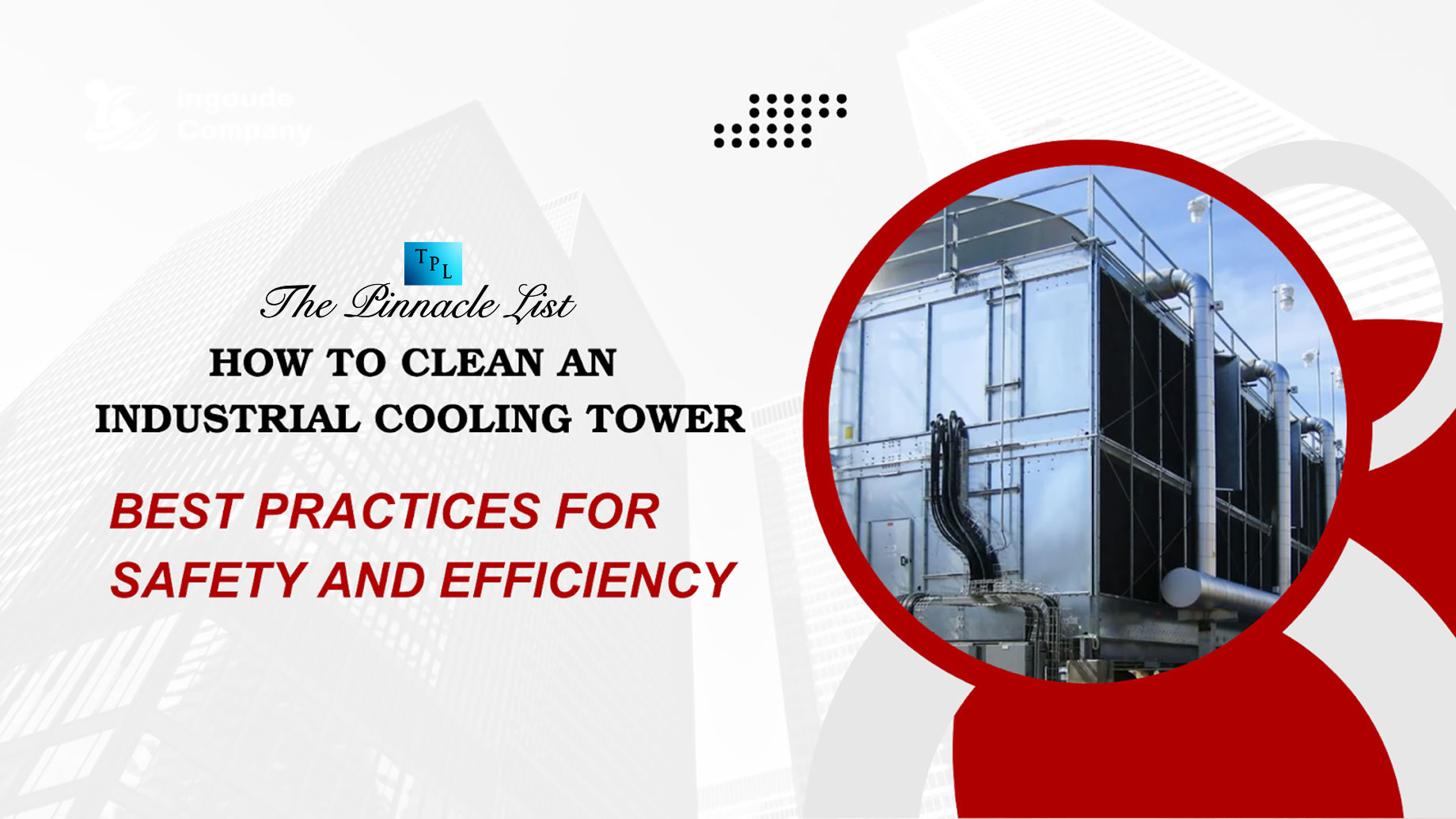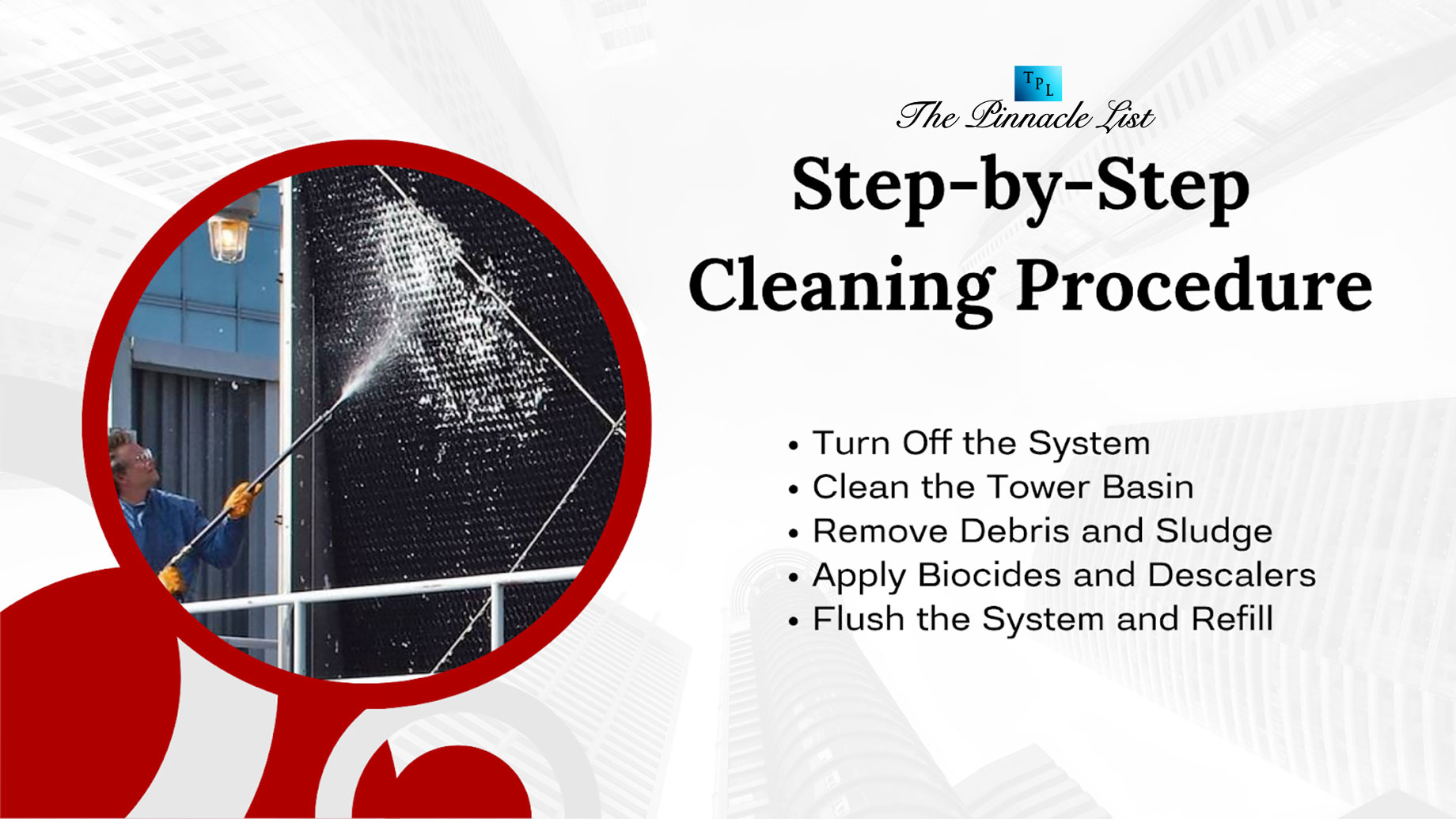
When was the last time your cooling tower was cleaned or your hired cleaning expert? Neglecting this task can lead to reduced efficiency and serious health risks, such as the growth of legionella bacteria. Proper maintenance ensures your system operates effectively and keeps everyone safe.
This guide will walk you through how to clean an industrial cooling tower, highlight best practices for maximizing safety and efficiency, and discuss common mistakes to avoid.
What is an Industrial Cooling Tower?
A cooling tower system is a heat removal system that uses water and air to lower the temperature of a facility’s equipment or processes. By recirculating water, the tower dissipates heat effectively, ensuring equipment operates at optimal temperatures. These systems are integral to maintaining industrial safety, productivity, and compliance with environmental standards.
Understanding Cooling Tower Cleaning
It’s a detailed process that requires specialized equipment, expertise, and adherence to health and safety protocols. Here are the key components of a professional cooling tower cleaning:
- Thorough Inspection: Identify corrosion, fouling, or scaling in areas such as the tower basin, fan housing, and drift eliminators.
- Comprehensive Cleaning: Removal of debris, sludge, and bacteria, ensuring all parts of the tower remain operational and sanitized.
Professional cleaning should always focus on minimizing risks to both personnel and the environment.
Pre-Cleaning Preparation
Preparation is critical to both the safety and success of cleaning your cooling tower. It ensures that the process is efficient, minimizes risks, and helps maintain the longevity of your equipment. Here’s what it entails:
- Shut Down the System: Turn off the cooling tower to prevent accidents during cleaning. Drain all water to provide a clear working area.
- Inspect the Tower: Check for any signs of corrosion, or fouling. This allows you to identify areas that may require special treatment.
- Wear Personal Protective Equipment (PPE): Cleaning involves exposure to bacteria and chemicals, so proper PPE, including gloves, masks, and goggles, is essential.
- Clear the Area: Remove any obstacles around the cooling tower to ensure safe access.
Does your team follow these steps every time? If not, consider implementing a checklist to improve safety and efficiency.
Step-by-Step Cleaning Procedure

Step 1: Turn Off the System
Before starting, ensure the cooling tower is completely powered down. This includes disconnecting the electrical power source and shutting off water flow to the tower. Draining all water from the system is critical to prevent any residual moisture from interfering with the cleaning process. Taking these precautions safeguards both the equipment and personnel involved.
Step 2: Clean the Tower Basin
The basin is a common area for dirt, debris, and harmful bacteria to accumulate.
- Pressure Washing: Use a pressure washer to thoroughly remove biological growth, dirt, and sludge that settle at the bottom of the basin. This step prevents contamination from spreading during operation.
- Inspect for Damage: Examine the water basin for signs of scaling, corrosion, or cracks. Left untreated, these issues can compromise system efficiency and shorten equipment lifespan. Repair any damage immediately using epoxy coatings or other sealing methods.
- Disinfection: Apply a biocide solution to the basin to kill harmful bacteria such as Legionella, which can cause severe health risks. Choose EPA-approved biocides and follow the manufacturer’s instructions for optimal effectiveness.
Step 3: Remove Debris and Sludge
- Fan Housing: Clean the cooling tower fan blades and housing to maintain proper airflow.
- Drift Eliminators: Use a low-pressure washer to clean drift eliminators, which trap water droplets. Avoid harsh chemicals that could degrade sensitive materials.
- Spray Nozzles: Remove and unclog nozzles to ensure even water distribution. A mixture of mild detergent and water can help loosen stubborn debris.
Step 4: Apply Biocides and Descalers
Biocides and descalers are essential for maintaining the health and efficiency of your cooling tower.
- Biocides: These chemicals kill harmful microorganisms. Alternating between oxidizing (e.g., chlorine) and non-oxidizing biocides helps prevent bacteria from developing resistance.
- Descalers: Mineral deposits, or scale, can form on heat exchange surfaces, reducing the system’s efficiency. Use a descaler to dissolve these deposits, following recommended dosages and contact times.
Allow biocides and descalers ample time to work, as rushing this step can reduce effectiveness.
Step 5: Power Wash the Fill Materials and Drift Eliminators
Fill materials and drift eliminators are critical for proper heat exchange and minimizing water loss.
- Fill Materials: These provide surface area for water to cool as it circulates. Over time, dirt and scale buildup can obstruct airflow and reduce cooling efficiency. Scrub or power wash the fill materials gently to avoid damage.
- Drift Eliminators: Clean these components to ensure they effectively capture water droplets, minimizing water loss and preventing the spread of harmful aerosols.
Regular cleaning of these parts not only improves system performance but also prolongs the life of the cooling tower.
Step 6: Flush the System and Refill
- Flushing: Use clean water to wash the system multiple times. This will ensure no residual chemicals or debris interfere with system operation.
- Refilling the Tower: Fill the system with treated water that has been filtered and chemically balanced. Proper water treatment reduces the risk of scaling, corrosion, and biological growth, enhancing both safety and efficiency.
By following these expanded steps, you can ensure your cooling tower operates safely, efficiently, and in compliance with industry standards.
Cooling Tower Best Practices
To ensure long-term safety, peak performance, and energy efficiency, follow these essential and surprisingly simple best practices for cooling tower cleaning, it’s not just maintenance, it’s the key to keeping your system running like a pro!
- Regular Inspections: Perform routine checks for corrosion, debris, or fouling to catch issues early.
- Frequent Maintenance: Schedule quarterly or bi-annual cleanings based on your cooling tower’s location, usage, and water quality.
- Effective Water Treatment: Monitor and treat the water to reduce mineral buildup and prevent bacterial growth.
- Record Keeping: Maintain detailed logs of inspections, maintenance, and cleaning to track performance over time.
Frequency of Cleaning
Cooling tower cleaning is typically recommended at quarterly or bi-annual intervals. However, the exact frequency can vary based on key factors:
- Location: Towers in urban or industrial areas often collect more debris.
- Usage: Continuous operation accelerates buildup.
- Water Quality: Hard water contributes to scaling, requiring more frequent cleaning.
Understanding these factors can help ensure your cooling tower remains efficient and well-maintained.
Advantages of Professional Cooling Tower Cleaning Services
Professional services offer numerous benefits:
1. Expert Knowledge & Specialized Skills
Professional cleaners bring advanced expertise and industry-specific skills to effectively eliminate contaminants, biofilm, and scale buildup. Their precision cleaning prevents bacterial growth and system malfunctions, ensuring optimal cooling tower performance.
2. Significant Time Savings
Outsourcing to professionals frees your maintenance team from time-consuming cleaning tasks, allowing them to focus on core operations and strategic growth—boosting overall productivity and operational efficiency.
3. Cutting-Edge Tools & Technology
Experts utilize state-of-the-art equipment and innovative cleaning techniques that deliver deeper, more thorough results than standard methods, enhancing system reliability and energy efficiency.
4. Risk Mitigation & Regulatory Compliance
With comprehensive knowledge of industry regulations and safety protocols, professionals minimize health risks like Legionella, ensure compliance, and reduce costly downtime or legal penalties.
5. Long-Term Cost Savings
Though professional services are an investment, they prevent expensive repairs, lower energy consumption, and extend equipment life, resulting in significant savings over time.
6. Extended Equipment Lifespan
Regular expert cleaning protects your cooling tower from corrosion and damage, significantly prolonging its operational life and delaying costly replacements.
7. Enhanced Health & Safety
By effectively controlling harmful bacteria and contaminants, professional cleaning safeguards worker health and prevents outbreaks of waterborne diseases such as Legionnaires’ disease.
If your team lacks the time or expertise, hiring professional cooling tower cleaning services is a strategic investment that safeguards your equipment, reduces risks, and boosts operational efficiency for long-term sustainability.
Conclusion
Proper cooling tower maintenance is vital for ensuring safer and more efficient industrial operations. Routine cleaning and upkeep significantly reduce health risks, such as bacterial growth, while also lowering overall energy costs. Additionally, regular maintenance extends the lifespan of your equipment, minimizing downtime and costly repairs. By prioritizing the care of your cooling tower, you are investing in sustainability, boosting productivity, and supporting long-term operational efficiency. Consistent attention to cooling tower maintenance not only protects your workforce but also improves system performance and compliance with safety standards. Ultimately, maintaining your cooling tower is a smart, proactive strategy for any industrial facility seeking reliable and cost-effective operations.
Frequently Asked Questions
Why is regular cooling tower maintenance important?
Regular maintenance prevents bacteria growth, reduces energy consumption, and extends equipment lifespan.
How often should a cooling tower be cleaned?
Most experts recommend cleaning at least twice a year, but frequency may vary based on usage and environment.
What are the risks of neglecting cooling tower maintenance?
Neglect can lead to health hazards like Legionella, increased energy costs, system breakdowns, and reduced efficiency.
Does proper maintenance improve cooling tower efficiency?
Yes, regular maintenance ensures optimal heat exchange, lowers energy bills, and enhances overall system performance.
How does cooling tower maintenance support sustainability?
Maintenance reduces water and energy waste, minimizes chemical usage, and helps facilities meet environmental compliance standards.